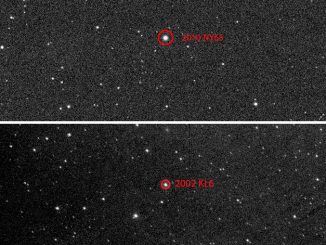
At 10:09 UT (11:09am BST) on 3 September 2018, 2015 FP118 passes just 4.7 million kilometres from Earth, or 12¼ times the average distance of the Moon. FP118 features on the Minor Planet Center list of Potentially Hazardous Asteroids (PHAs), but no approach as close as the September 2018 flyby occurs within the next 173 years.

Although closest to Earth on 3 September, 2015 FP118’s phase angle is changing and its brightness is still increasing as the asteroid gets farther away. As darkness falls on the UK night of 4 September you can find FP118 amid the stars of northern Cepheus close to magnitude +4.4 star pi (π) Cephei. The asteroid is predicted to glow at magnitude +14.7 this night, which means it’s a viable target for 10-inch (25-cm) aperture backyard ‘scopes and larger under moonless skies (note: the 24-day-old waning crescent Moon rises in the UK around 12:30am BST on 5 September). FP118’s motion against the background stars presently exceeds 9 degrees/day.
Observers with computerised GoTo mounts or digital setting circles may prefer to locate 2015 FP118 from the hourly topocentric ephemeris computed for the centre of the British Isles found at the bottom of the page.
The night of 5–6 Sep 2018
As darkness falls in Western Europe, the NEO is 13.3 lunar distances (5.1 million kilometres) from Earth and predicted to be magnitude +14.6 amid the stars of Cepheus. FP118 crosses the constellation border into Cassiopeia shortly before 1am BST on 6 September when it’s travelling at a rate close to one-third of a degree per hour against the stars.
The night of 6–7 Sep 2018
As darkness blankets the British Isles on 6 September, 2018 FP118 lies in an easily located position amid the familiar W-shaped constellation of Cassiopeia high in the northeastern sky. Throughout the hours of darkness the asteroid lies within the triangle bounded by gamma (γ), beta (β) and alpha (α) Cassiopeiae, stars more commonly known as Navi, Caph and Schedar, respectively. The asteroid is brightest this night, a magnitude +14.5 dot some 14½ lunar distances away moving towards Schedar at a rate equivalent to the diameter of the full Moon every 100 minutes.
The night of 7–8 Sep 2018
The asteroid is now approaching 16 lunar distances or 6 million kilometres from Earth and its motion against the stars of Cassiopeia has slowed to about the diameter of the full Moon every two hours. FP118 is predicted to be magnitude +14.6 this night.
The night of 8–9 Sep 2018
As dusk fades to dark in the UK on 8 September the asteroid lies in southern Cassiopeia between magnitude +4.5 star omicron (ο) Cassiopeiae and magnitude +4.3 phi (φ) Andromedae. The space rock is still around magnitude +14.6 as it crosses the constellation border into Andromeda close to 3am BST on 9 September.
The night of 9–10 Sep 2018
This is the night many astrophotographers may be waiting for since 2015 FP118 lies within 4 degrees east of the Andromeda Galaxy, Messier 31. Throughout the hours of UK darkness the magnitude +14.7 asteroid moves around 1½ degrees against the background stars, crossing a line drawn between magnitude +4.3 phi (φ) Andromedae and magnitude +3.8 mu (μ) Andromedae.
See asteroid 2015 FP118 live online
If you are clouded out or don’t have a telescope large enough to see or image it, then why not follow this fascinating NEO online? The Virtual Telescope Project 2.0 is hosting a live event starting at 21:30 UT (10:30pm BST) on 3 September.



